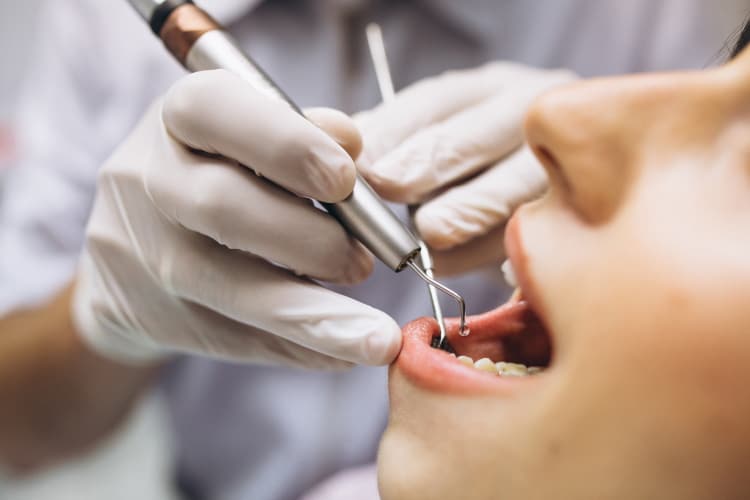Having a cracked tooth in your mouth can be excruciating — but does it warrant an emergency dentist visit? Well, to be completely honest, if your tooth has cracked, you probably have some underlying issues to address anyway.
After all, enamel, the outermost layer of our teeth, is the strongest of all the substances that make up our bodies. It’s supposed to make our teeth last a lifetime — though, in reality, it rarely does. Still, if something has weakened that barrier enough to cause it to crack, you should most certainly consider it a dental emergency.
Clenching our teeth and chewing hard foods can certainly cause that enamel to crack. Yet if the fissure isn’t deep enough, we may not even register the damage immediately. But letting a broken tooth go untreated for a long time can have dire consequences. Most notably, those fissures can invite the acid-producing bacteria that cause cavities inside our teeth!
Suffice to say, avoiding hard foods and working on nervous habits like teeth grinding will be our main line of defense in this case. Still, there’s always a chance that, if or when we do crack a tooth or even a filling, we won’t realize right away. That’s one of the many reasons everyone should get regular dental checkups. Even if we don’t notice a cracked filling or tooth, a professional certainly would!
If you’re experiencing the symptoms that are associated with having a chipped tooth, you should seek out emergency dental services as soon as possible. If nothing else, doing so may minimize the amount of work your dentist will have to do. With that in mind, let’s talk about some of the symptoms you should keep in mind.
When Should You Start Looking for a Good Walk-In Dentist?
If you’ve never experienced a cracked tooth, count your blessings! A tooth emergency of that magnitude generally comes with a score of painful symptoms, including:
- Discomfort while eating
- Sensitivity to sweet, cold, and hot foods
- Gum inflammation and swelling
- Bloody gums
Usually, the pain comes and goes depending on various conditions. As we have mentioned, it’ll be particularly painful after chewing since that activity brings blood to the gums. In addition to making the area feel like it’s pulsating, the rush of blood also brings white blood cells to the area to fight off any potential infection. That’s why chewing can often result in swollen and irritated gums if the crack in your tooth has let bacteria through to the nerves and blood vessels in its core.
That acid-producing bacteria lives on the surface of our teeth anyway, and it doesn’t need much of an invitation to come inside. Since the dentin beneath the enamel is quite porous, it’s only a matter of time before the bacteria makes its way to the pulp chamber that houses the nerve endings. That’s also why sweet and cold foods affect us so much when we have a deep crack in our teeth.
What Are the Most Common Cracked Filling Symptoms?
The symptoms of a cracked filling are pretty much the same as those you might experience with a chipped tooth. A filling should ideally act as your tooth, so damaging it will be the same as damaging a tooth. However, if we got the filling after a root canal surgery, we may not feel any discomfort at all. After all, root canal procedures remove all the nerve endings in the tooth.
Therefore, you might have to rely upon other indicators of a cracked filling. For example, you might:
- Spit out a chunk of the filling after biting down on something hard
- Feel the sharp crack with your tongue or finger when you run it over your teeth
- Notice dark spots that aren’t a part of any silver amalgam fillings
- Look for visible fractures and missing pieces of the filling
- Remember when you got your fillings and figure out if they’re past their best before date
After all, the material your fillings are made of can affect their longevity. For example, ceramic fillings can last for about seven years, and composite ones that match your tooth color should be good for five years.
Conversely, gold and amalgam fillings can both last for about fifteen years. However, those silver-mercury fillings can cause a range of cracked amalgam filling symptoms. Since they don’t bond to the tooth structure, they will eventually allow bacteria to slip into the tooth.
In any case, spotting a cracked filling may be more difficult than realizing that you have a broken tooth, you might just have to get an X-ray to find which of your fillings needs repairs. Still, knowing this information might help you opt for a certain type of filling when you seek out emergency dental care.
What Will Happen When You Visit an Emergency Dentist?
After dealing with pain for a few days, you might decide that the most reasonable response to this particular tooth emergency would be to head on over to the nearest walk-in dentist. However, we would caution against that. Instead, you should make sure to vet any emergency dental services you find. Trust us, you don’t want to deal with a botched procedure or put up with any unnecessary pain at this point.
If you find a decent emergency dentist, their treatment solution should be pretty straightforward. They’ll probably ask you a few questions about your dental history to determine if you have a habit of grinding your teeth. If they notice any damage on your other teeth, they might recommend a mouthguard after they fix your cracked tooth.
As for the tooth itself, before they do any work on it, they’ll have to spot the crack. Some cracks are going to be more obvious than others. If yours is particularly stealthy, they might use dental dye to make it stand out. Alternatively, they’ll blow cold air around your teeth until your reaction makes the location of the crack evident. Lastly, they might perform an X-ray that will show if they need to perform a root canal procedure too. Once they find the crack, they’ll have to remove any old fillings you have in the tooth. If the crack in the enamel is deep enough, they might drill down (after giving you an anesthetic, naturally) to take out any affected areas. Then, they’ll fill the crack with plastic resin or put in a full crown if that doesn’t cut it. In the worst-case scenario, a dentist might have to remove the entire tooth, though that’s usually not necessary.
The Importance of Getting Your Cracked Tooth Fixed
If you don’t see a dentist as soon as you realize that you have a cracked tooth, you’ll regret it! Allowing bacteria to wreak havoc inside your tooth can cause a terrible infection. You might get pockets full of pus around the infected tooth which would make your breath smell truly atrocious.
Furthermore, gum inflammation can easily induce a full-body fever — so don’t put treatment off until the last second! Go to a dentist as soon as you feel any pain. Even if it turns out to be benign, at least you’ll know your teeth are healthy.







